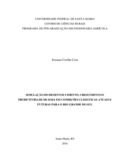| dc.creator | Cera, Jossana Ceolin | |
| dc.date.accessioned | 2016-07-04 | |
| dc.date.available | 2016-07-04 | |
| dc.date.issued | 2016-02-18 | |
| dc.identifier.citation | CERA, Jossana Ceolin. SIMULATING DEVELOPMENT, GROWTH, AND YIELD OF SOYBEAN UNDER CURRENT AND FUTURE CLIMATE FOR THE RIO GRANDE DO SUL. 2016. 98 f. Tese (Doutorado em Engenharia Agrícola) - Universidade Federal de Santa Maria, Santa Maria, 2016. | por |
| dc.identifier.uri | http://repositorio.ufsm.br/handle/1/3635 | |
| dc.description.abstract | Soybean is a mainly agricultural world commodity, with United States, Brazil, and Argentina as mainly producers. This thesis had as objectives (i) evaluate the SoySim model to simulate growth, development, and yield of soybean cultivars with maturity groups greater than 4.2 in a subtropical region of Brazil and (ii) simulate the soybean yield potential and rainfed in the Rio Grande do Sul State in two climate futuro scenarios of IPCC (SRES A1B and RCP4.5) with the crop models SoySim and CROPGRO-Soybean. To reach the first objective, were used data from field experiments with 20 soybean cultivars, in 38 diferent sowing dates during 2010/2011, 2011/2012, 2012/2013, 2013/2014 and 2014/2015 growing seasons, in 12 locations at Rio Grande do Sul State. The soybean cultivars have maturity group varying between 4.8 and 8.2 and indeterminate and semi-determinate growth habit. The evaluation of the SoySim model show reasonable simulations of the variables of the V-stage and R-stage, final node number, and yield, but in general, the simulations that had the lower errors, were those with maturity groups lower than 6.0. For the second objective, the simulations with the emission scenarios SRES A1B and RCP4.5 forcing the crop models SoySim and CROPGRO-Soybean showed an increase on soybean yield in Rio Grande do Sul State until the end of the XXI century, with a positive change around 2 Mg ha-1 for the 2070-2099 period related to the baseline (1980-2009). | eng |
| dc.description.sponsorship | Conselho Nacional de Desenvolvimento Científico e Tecnológico | |
| dc.format | application/pdf | por |
| dc.language | por | por |
| dc.publisher | Universidade Federal de Santa Maria | por |
| dc.rights | Acesso Aberto | por |
| dc.subject | Glycine max (L.) Merr | por |
| dc.subject | Modelo SoySim | por |
| dc.subject | Modelo CROPGRO-Soybean | por |
| dc.subject | Cenários climáticos futuros | por |
| dc.subject | Glycine max (L.) Merr | eng |
| dc.subject | SoySim model | eng |
| dc.subject | CROPGRO-Soybean model | eng |
| dc.subject | Future climate scenarios | eng |
| dc.title | Simulação do desenvolvimento, crescimento e produtividade de soja em condições climáticas atuais e futuras para o Rio Grande do Sul | por |
| dc.title.alternative | Simulating development, growth, and yield of soybean under current and future climate for the Rio Grande do Sul | eng |
| dc.type | Tese | por |
| dc.description.resumo | A soja é a principal commodity agrícola mundial, sendo os Estados Unidos, Brasil e Argentina os principais produtores. Esta tese teve como objetivos (i) avaliar o modelo SoySim na simulação do crescimento, desenvolvimento e rendimento de cultivares de soja com grupo de maturação maior que 4.2 na região subtropical do Brasil e (ii) simular a produtividade potencial e com limitação por água em soja no Estado do Rio Grande do Sul em dois cenários climáticos futuros do IPCC (SRES A1B e RCP4.5) com os modelos SoySim e CROPGRO-Soybean. Pra alcançar o primeiro objetivo, foram usados dados de experimentos de campo com 20 cultivares de soja, em 38 diferentes datas de semeadura durante os anos agrícolas de 2010/2011, 2011/2012, 2012/2013, 2013/2014 e 2014/2015, em 12 locais no Rio Grande do Sul. As cultivares de soja utilizadas possuem grupo de maturação variando entre 4.8 e 8.2 e tipo de crescimento indeterminado e semi-determinado. A avaliação do modelo SoySim mostrou razoável simulação dos estágios vegetativos e reprodutivos, número final de nós e produtividade, mas no geral, as simulações que obtiveram os menores erros foram aquelas com grupo de maturação menor que 6.0. Para o segundo objetivo, as simulações com os cenários de emissões SRES A1B e RCP4.5 forçando os modelos agrícolas SoySim e CROPGRO-Soybean mostraram um aumento na produtividade de soja no Rio Grande do Sul até o final do século XXI, com anomalia positiva de até 2 Mg ha-1 no período de 2070-2099 em relação ao período baseline (1980-2009). | por |
| dc.contributor.advisor1 | Streck, Nereu Augusto | |
| dc.contributor.advisor1Lattes | http://buscatextual.cnpq.br/buscatextual/visualizacv.do?id=K4721150P1 | por |
| dc.contributor.referee1 | Durigon, Angelica | |
| dc.contributor.referee1Lattes | http://lattes.cnpq.br/8404003252073790 | por |
| dc.contributor.referee2 | Tatsch, Jônatan Dupont | |
| dc.contributor.referee2Lattes | http://lattes.cnpq.br/2365902346826079 | por |
| dc.contributor.referee3 | Timm, Andréa Ucker | |
| dc.contributor.referee3Lattes | http://buscatextual.cnpq.br/buscatextual/visualizacv.do?id=K4778210D6 | por |
| dc.creator.Lattes | http://buscatextual.cnpq.br/buscatextual/visualizacv.do?id=K4291686U4 | por |
| dc.publisher.country | BR | por |
| dc.publisher.department | Engenharia Agrícola | por |
| dc.publisher.initials | UFSM | por |
| dc.publisher.program | Programa de Pós-Graduação em Engenharia Agrícola | por |
| dc.subject.cnpq | CNPQ::CIENCIAS AGRARIAS::ENGENHARIA AGRICOLA | por |


